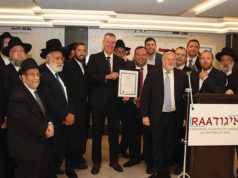 A Proud History
A Proud History
Yemenite Jewry represents a proud and unique heritage, replete with great rabbis, philosophers, poets, judges, and community leaders. They maintain the traditions of a Jewish community that hardly experienced Western or European influences on dress, mode of prayer, and pronunciation. But they have experienced other incursions of the outside world: persecutions, economic sanctions, and expulsions.
In the 12th century, Maimonides (the Rambam), preeminent Jewish leader, physician, halakhist, and philosopher wrote the Iggeret Teman (Letter to the Jews of Yemen) to give reassurance to Jews facing unbearable persecution under local Shiite rulers. He intervened several times to protect the Jewish community living in Yemen, thereby earning eternal mention in the local Yemenite version of the Kaddish. Indeed the Yemenite community still remains loyal to the teachings of Maimonides some 800 years after his death.
The 17th century marked a period of forced conversions, destruction and treacherous marches of exile in some parts of Yemen. The Yemenite Jews, so vital to the fabric of their local communities, were nevertheless invited by the ruler of Sana’a to return. However, during subsequent periods, despite political turmoil and tribal war throughout the country, great leaders flourished. These included halakhists like Rabbi Abraham Halevi Alshek and Rabbi Shelomo Yosef Kara; poet Shalom Shabazi; the mystic Rabbi Sharabi; and the kings finance minister, Shalom Araqi Cohen.
On American Soil
In the late 1920’s, a group of Yemenite families arrived together on the Lower East Side of Manhattan. They founded two synagogues, and became the nucleus for a large and important group of Yemenite Jews.
The men worked as silversmiths, jewelers and filigree craftsmen, carrying on traditions of 20 centuries. They were also learned, steeped in the oral traditions of their heritage.
Later, about half of the original group moved to Boro Park, Brooklyn, where congregation Ohel Shalom was established. The fledgling synagogue made several moves before settling into an old building at 45th Street and 12th Avenue.
The families grew and prospered. Today, these original families and their descendants are still in contact with each other; Yemenite Jews, both in Israel and in far-flung communities throughout North America.
The new generations have embraced the opportunities of America, becoming scientists, engineers and businessmen. Many used the skills they learned in childhood—as talented apprentice jewelers—to work their way through high school and college. They have moved to burgeoning new Jewish communities in the suburbs. Their children, who do receive a Jewish education, are becoming less interested in Yemenite customs. The unique liturgy and nusah is being practiced and preserved by fewer and fewer descendants on American soil.
Thus today, within the framework of freedom and democracy, the Yemenite community confronts new challenges in passing the rich and sacred customs and traditions on to younger generations. These challenges include assimilation and secularization, risking the loss of the ancient community’s customs, rituals, identity and heritage. In addition, the riches of the Yemenite Jewish heritage offer much to the Sephardic and Ashkenazic communities, and should be made widely available to the Jews of Oriental and Western European descent.
In Eretz Yisrael
Throughout the centuries the Jewish community of Yemen maintained an unbroken contact with the Jewish settlement in Eretz Yisrael. A turning point for the Jews of Yemen was the beginning of their aliyot to Eretz Yisrael in significant numbers in 1881. Several waves of immigration in the following years brought the number of Yemenite Jews to comprise about 6% of the entire Jewish population there. The aliyot from Yemen continued through the Mandate Period until the mass exodus on “The Wings of Eagles” in the years 1949-50. The Yemenite settlements, both in urban and in rural areas in Israel, represent a significant contribution to the overall process of the rejuvenation of the Jewish homeland. While most Yemenite Jews immigrated to Israel, important communities also developed in Egypt, India, and later in London and New York.



